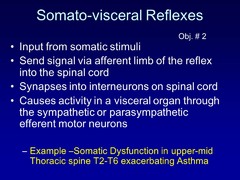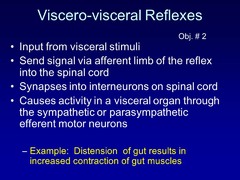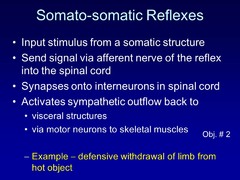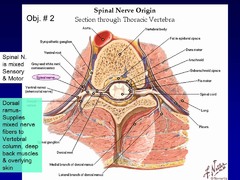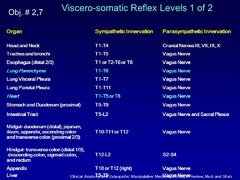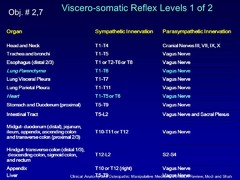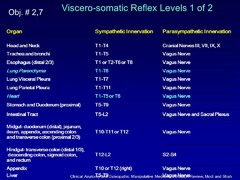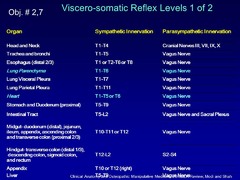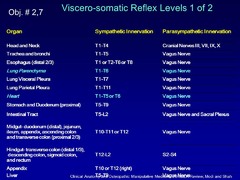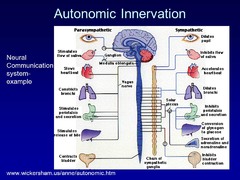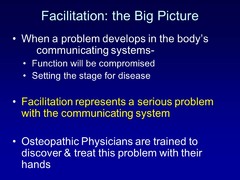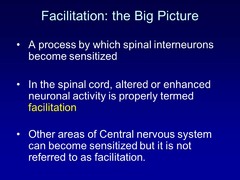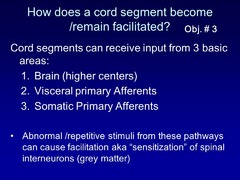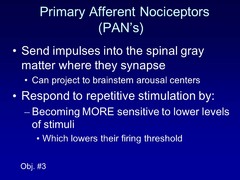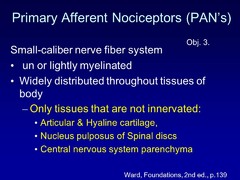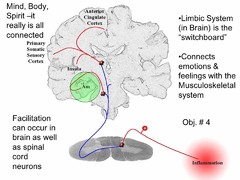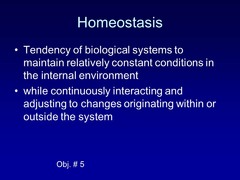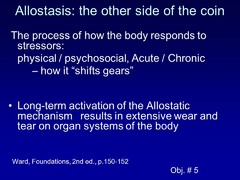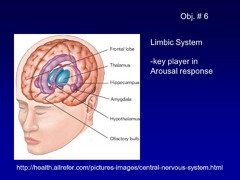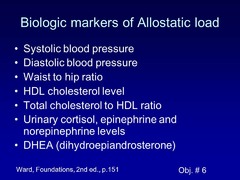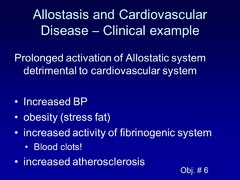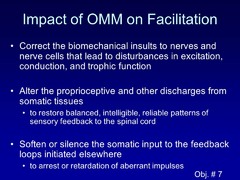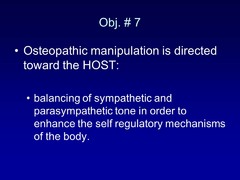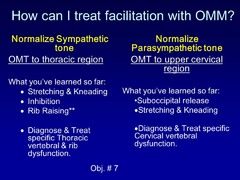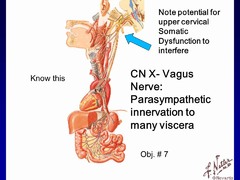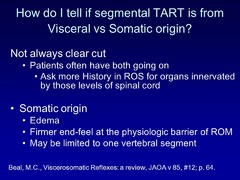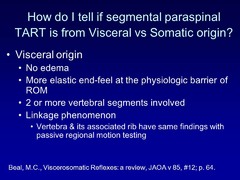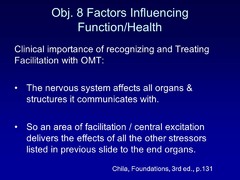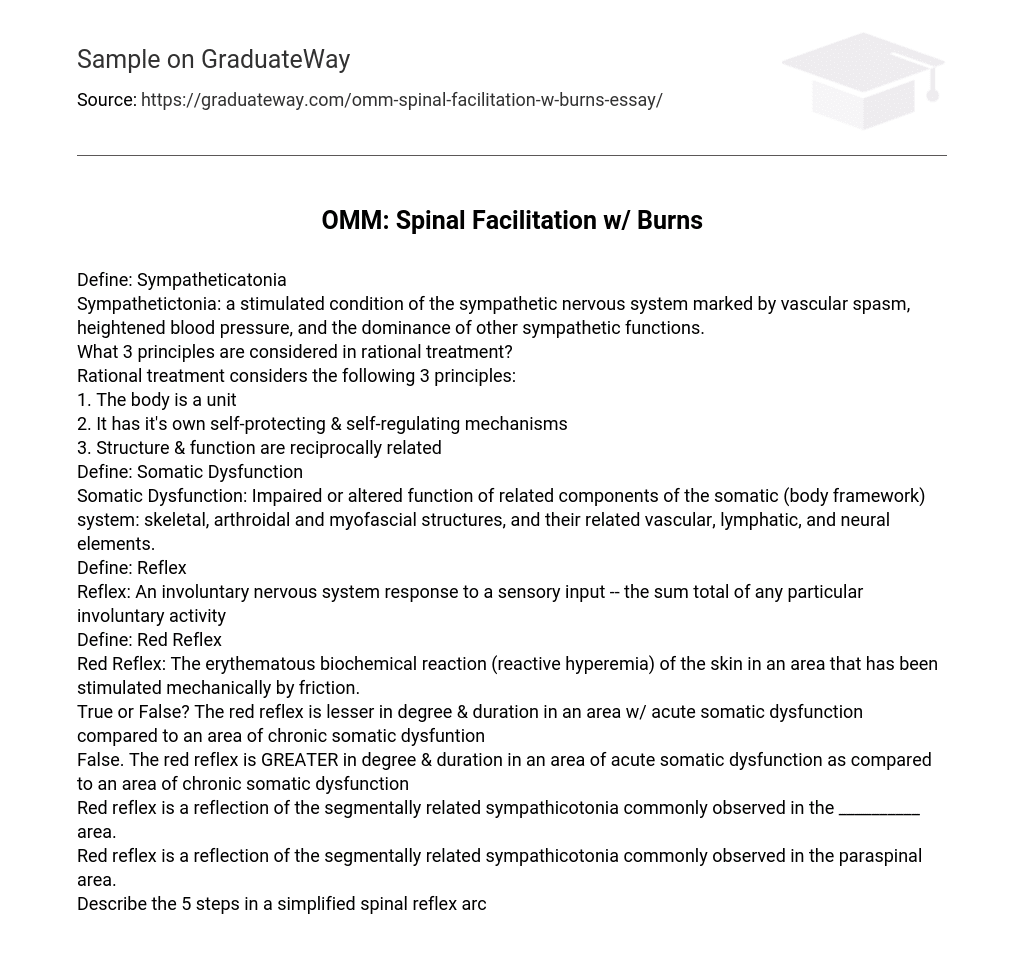Define: Sympatheticatonia
Sympathetictonia: a stimulated condition of the sympathetic nervous system marked by vascular spasm, heightened blood pressure, and the dominance of other sympathetic functions.
What 3 principles are considered in rational treatment?
Rational treatment considers the following 3 principles:
1. The body is a unit
2. It has it’s own self-protecting & self-regulating mechanisms
3. Structure & function are reciprocally related
Define: Somatic Dysfunction
Somatic Dysfunction: Impaired or altered function of related components of the somatic (body framework) system: skeletal, arthroidal and myofascial structures, and their related vascular, lymphatic, and neural elements.
Define: Reflex
Reflex: An involuntary nervous system response to a sensory input — the sum total of any particular involuntary activity
Define: Red Reflex
Red Reflex: The erythematous biochemical reaction (reactive hyperemia) of the skin in an area that has been stimulated mechanically by friction.
True or False? The red reflex is lesser in degree & duration in an area w/ acute somatic dysfunction compared to an area of chronic somatic dysfuntion
False. The red reflex is GREATER in degree & duration in an area of acute somatic dysfunction as compared to an area of chronic somatic dysfunction
Red reflex is a reflection of the segmentally related sympathicotonia commonly observed in the __________ area.
Red reflex is a reflection of the segmentally related sympathicotonia commonly observed in the paraspinal area.
Describe the 5 steps in a simplified spinal reflex arc
True or False? All reflexes have an Efferent arm bringing impulses to CNS, a central arm w/in the CNS that is more than just 1 interneuron, & an Afferent arm taking impulses to peripheral structures
False! All reflexes have an AFFERENT arm bringing impulses to CNS, a central arm w/in the CNS that is more than just 1 interneuron, & an EFFERENT arm taking impulses to peripheral structures
True or False? Afferent neurons enter dorsally & Efferent neurons exit ventrally
True
Describe how the multiple pathways of Interneurons affect sensory input & what this means for reflex pathways
Interneurons have multiple pathways:
*They process & complicate the sensory input*They can ascent/descend, branch & crossover*This overlap of inputs onto common interneurons is the basis for reflex pathways
*Explains how visceral disturbance can activate skeletal muscle & vice-versa
This essay could be plagiarized. Get your custom essay
“Dirty Pretty Things” Acts of Desperation: The State of Being Desperate
writers
ready to help you now
Get original paper
Without paying upfront
True or False? Almost every interneuron that receives visceral nociceptive input also receives input from a somatic source
True
True or False? Only 20% of interneurons that receive input from somatic structures also receive visceral input
False. Almost 80% of interneurons that receive input from somatic structures also receive visceral input
Define the Viscero-somatic reflex pathway
Viscero-somatic: visceral sensory input produces a reflex response in a segmentally related somatic structure
Define the Somato-visceral reflex pathway
Somato-visceral: Somatosensory input produces a reflex response in a segmentally related visceral structure
Define the Somato-somatic reflex pathway
Somato-somatic: Somatosensory input produces a reflex response in a segmentally related somatic structure
Define the Viscero-visceral reflex pathway
Viscero-visceral: Visceral sensory input produces a reflex response in a segmentally related visceral structure
Provide an example of Viscero-somatic reflex
A Viscero-somatic reflex: Asthma causing TART in upper-mid Thoracic facilitated segments
Describe the Viscero-somatic reflex
Provide an example of a Somato-visceral reflex
Somato-visceral reflex: Somatic dysfunction in upper-mid Thoracic spine T-2-T6 exacerbating asthma
Describe the Somato-visceral reflex
Provide an example of a Viscero-visceral reflex
Viscero-visceral: Distension of gut results in increased contraction of gut muscles
Describe the Viscero-visceral reflex
Provide an example for Somato-somatic reflexe
Somato-somatic: defensive withdrawal of limb from hot object
Describe the Somato-somatic reflex
To what does the Dorsal ramus supply mixed nerve fibers to?
The Dorsal ramus supplies mixed nerve fibers to:
*Vertebral column
*Deep back muscles
*Overlying skin
Identify the spinal nerve on a X-section of thoracic vertebra
Sympathetic innervation of the Head & Neck come from where?
Sympathetic innervation of the Head & Neck:
*T1-T4
Parasympathetic innervation of the head & neck come from Cranial Nerves III, VIII, IX, XI. True or False?
False. Parasympathetic innervation of the head & neck come from Cranial Nerves:
*III, VII, IX, X
From where does sympathetic innervation of the Trachea & bronchi come from?
Sympathetic innervation of the Trachea & bronchi come from:
*T1-T5
True or False? The Vagus nerve supplies parasympathetic innervation for the trachea & neck.
False. The Vagus nerve supplies parasympathetic innervation to the trachea & bronchi (and many, many other organs, but not the neck)
True or False? Sympathetic innervation of the lung parenchyma is from T1-T6
True.
True or False? Sympathetic innervation for the distal 2/3s of the Esophagus comes from T1 or T2 – T6 or T10
False! Sympathetic innervation for the distal 2/3s of the Esophagus comes from the T1 or T2 – T6 or T8
True or False? Only the distal 2/3 of the Esophagus is supplied parasympathetic innervation via the Vagus nerve
False. With the exception of some excretionary organs & genitalia, most everything south of the head is supplied parasympathetic innervation via the Vagus nerve.
True or False? Parasympathetic innervation of the Lung Parenchyma, Visceral Pleura & Parietal Pleura is done via the Vagus nerve
True.
True or False? Sympathetic innervation of these structures is such:
*Lung Parenchyma: T1-T7
*Lung Visceral Pleura: T1-T11
*Lung Parietal Pleura: T1-T6
False.
*Lung Parenchyma: T1-T6
*Lung Visceral Pleura: T1-T7
*Lung Parietal Pleura: T1-T11
Identify where Sympathetic innervation for the heart comes from. Parasympathetic innervation?
The Heart:
Sympathetic innervation: T1-T5 or T6
Parasympathetic innervation: Vagus Nerve
True or False? Sympathetic innervation for the proximal stomach & duodenum comes from T5-T9
True.
True or False? Parasympathetic innervation for the Intestinal tract comes exclusively from the Vagus nerve.
False. Vagus nerve & Sacral Plexus
Describe, in general, the organization of the autonomic innervation in terms of Parasympathetic & Sympathetic
True or False? Tissue texture changes (the 1st T in TART) can include:
*Red Reflex
*Increased skin drag (moisture)
*Edema
*Nociceptive reflex dynamic
False. Tissue texture changes can include:
*Red Reflex
*Increased Skin Drag (moisture)
*Edema
*Muscular Hypertonicity
Concerning evidence for SD, what did Louisa Burns, DO, do?
Louisa Burns, DO:
*SD of vertebral column = reproducible effects on visceral function & morphology
Concerning evidence for SD, what did Wilbur Cole, DO, do?
Wilbur Cole, DO:
*Delineated the pathway for effects of SD on visceral function
Concerning evidence for SD, what did J.S. Denslow, DO, do?
J.S. Denslow DO:
*Documented that areas of palpable TART showed histopathological changes of Edema & Inflammatory processes (mediated by: bradykinins, serotonin, histamines, potassium, substance P, leukotrienes, calcitonin gene related peptide)
Concerning Denslow’s research using EMG, describe the findings with the spinal segments.
Spinal segments with increased EMG had measurable TART:
*Red Reflex, increased sweat (skin drag) which are signs of increased sympathetic tone
Concerning Denslow’s research using EMG, describe the findings with the spinal cord
Spinal cord levels innervating these segments were facilitated:
*less pressure at these segments needed to produce EMG activity
*stimulating other areas of the back or creating psychological stress produced EMG activity at these segments
Identify 2 issues that arise from problems in the body’s communicating systems
When a problem develops in the body’s communicating systems:
*Function will be compromised
*Setting the Stage for Disease
True or False? Facilitation represents a serious problem with the communicating system
True
True or False? In the spinal cord, altered or enhanced neuronal activity is properly termed facilitation
True.
True or False? This is a part of the definition of Facilitation: The maintenance of a pool of neurons (premotor, motorneurons of preganglionic sympathetic neurons in one or more segments of the spinal cord) in a state of partial or sub-threshold excitation
True.
In Facilitation, why is less afferent stimulation required to trigger the discharge of impulses?
A pool of neurons are maintained in a state of partial or sub-threshold excitation, which means that less stimulation is required to trigger the discharge of impulses
True or False? Facilitation may be due to:
*sustained increase in efferent input
*abberant patterns of efferent input
*changes w/in the affected neurons (or in chemical environment)
False. Facilitation may be due to:
*Sustained increase in AFFERENT input
*Aberrent patterns of AFFERENT input
*Changes w/in the affected neurons, or their chemical environs
How can SD affect the chemical environment of a neuron?
Suboptimal environment for cellular function:
*lack of oxygen, buildup of metabolic wastes
*increased lactic acid, causing ph decreases (altered enzyme function, altered threshold for nerve depolarization)
Once facilitation has been established, it can be sustained by normal CNS activity even if the original injury has ________ or the insult has _________ .
Once facilitation has been established it can be sustained by normal CNS activity, even if the original injury has healed or the insult has been removed.
How does a cord segment become or remain facilitated?
Provide examples of Primary Afferents
Examples of primary Afferents:
*Proprioceptors (muscle spindles, golgi tendon organs)*Mechanoreceptors (Pacinian/meissner’s corpuscles, ruffini endings, merkel’s discs)*Nociceptors
*Sympathetic / Parasympathetic Afferents
What is Nociception?
Nociception: Excitation of the small-caliber primary afferent nerve endings by Mechanical, Thermal & Chemical stimuli
True or False? Even if nociception input doesn’t reach the conscious level as “pain” it can still facilitate spinal pathways
True.
Describe what Primary Afferent Nociceptors do (PANs)
Describe the structure of PANs. Where are they found?
Identify 4 ways that Facilitation correlates with SD
Facilitation correlation w/ SD:
*SD results in facilitation of spinal cord
*A facilitated segment can lead to SD (TART)
*It’s a vicious cycle
*PAN’s are involved in SD, Facilitation & and Allostasis
True or False? The proximity of the Sympathetic Chain Ganglia to the manubrium is an example of how SD can correlate w/ Facilitation via the affected chemical environment.
False. Proximity of Sympathetic chain ganglia to the Costovetebral junction can be an example…
Describe how Facilitation can work in the brain. What system is likely affected?
True or False? The limbic system inludes the hypothalamus, hippocampus, amygdala, pituitary gland, and several other areas
True.
Describe the interplay between SD / Spinal Facilitation / Allostatic Load
True or False? The Limbic systems is a key player in arousal response
True.
True or False? SD leads to inhibition of signals to the alteration of activity of the major communicating systems
False.
When stressed or threatened, the neuroendocrine immune system responds by rapidly releasing the “Three C’s.” What are they?
The 3 C’s:
*Catecholamines (Norepinephrine)
*Cortisol (Adrenal Corticosteroids)
*Cytokines
Identify the biological markers of allostatic load
What are some of the consequences of Allostasis & CV disease? What is happening to cause these things?
What is Axoplasmic flow?
Axoplasmic flow:
*Neurons aren’t just for carrying electrochemical impulses
*They carry Trophic substances that promote the health of the tissue that is being innervated — this is axoplasmic flow
By existing at levels of pressure too low to cause perceived pain, altered sensory or motor symptoms SD and disrupt what?
SD can disrupt axoplasmic flow via levels of pressure too low to cause perceived pain, altered sensory or motor symptoms
Describe the impact of OMM on Facilitation
Describe why OMM is directed toward the host. What are we trying to do?
Describe how to treat Facilitation w/ OMM in terms of Sympathetic & Parasympathetic tone
Describe why upper cervical SD can interfere with the rest of the body
How to tell if segmental TART is from Visceral or Somatic orgin? What is indicative of Somatic origin?
True or False? Segmental tart from Visceral origin will have these symptoms:
*No edema
*More elastic end feel at the physiologic barrier of ROM
*2 or more vertebral segments involved
*Linkage phenomenon (vertebra & its associated rib have same findings w/ passive regional motion testing)
True.
Identify some factors that influence health and function
Why is it of clinical importance to recognize & treat Facilitation w/ OMT?
Identify OMM mechanisms of Efficacy



